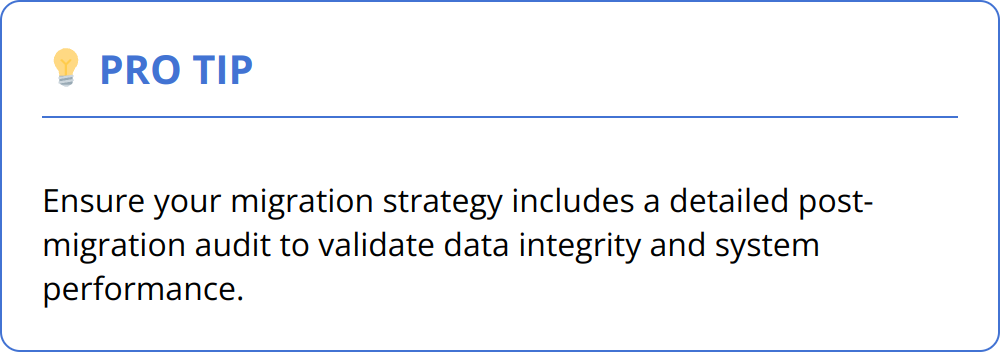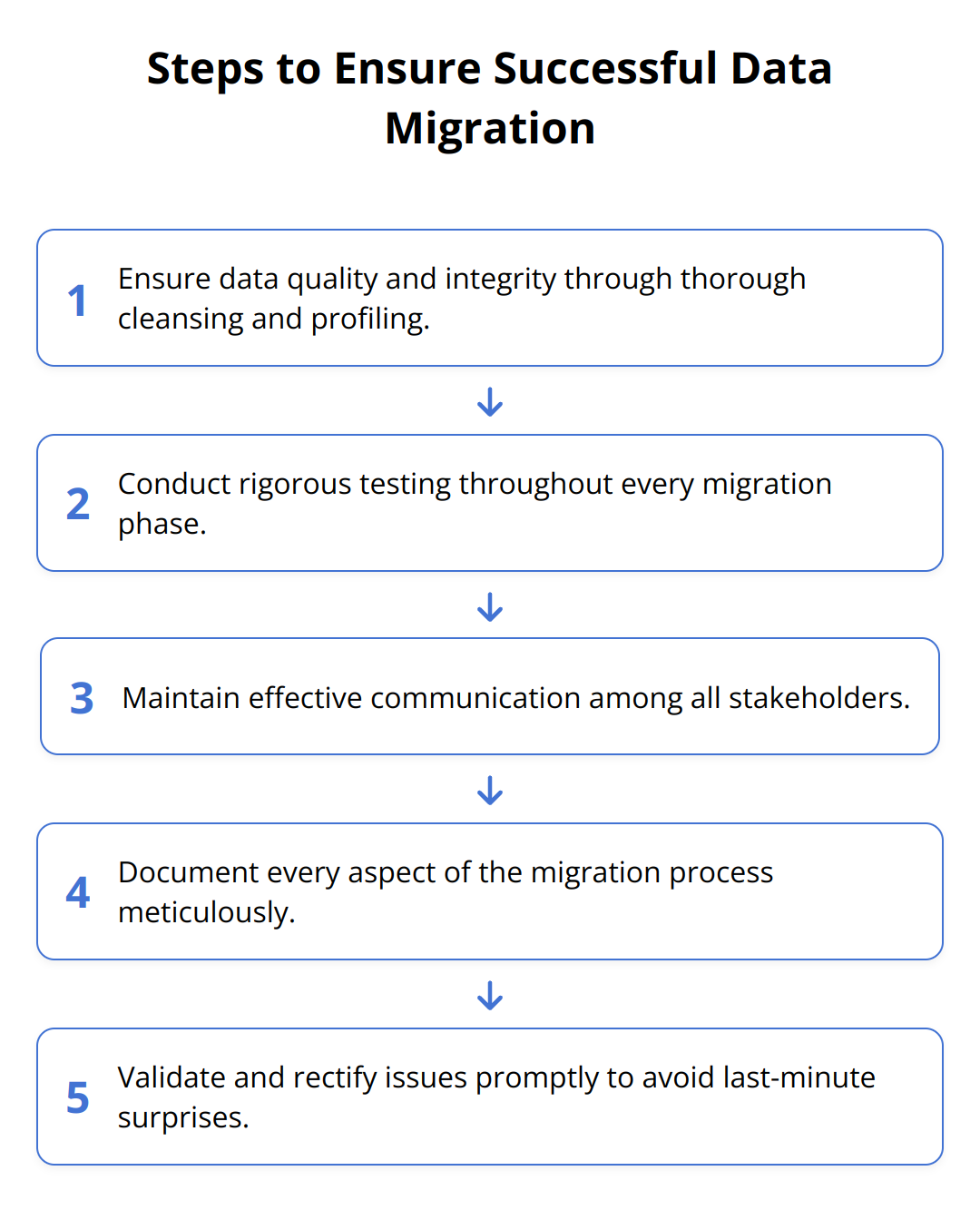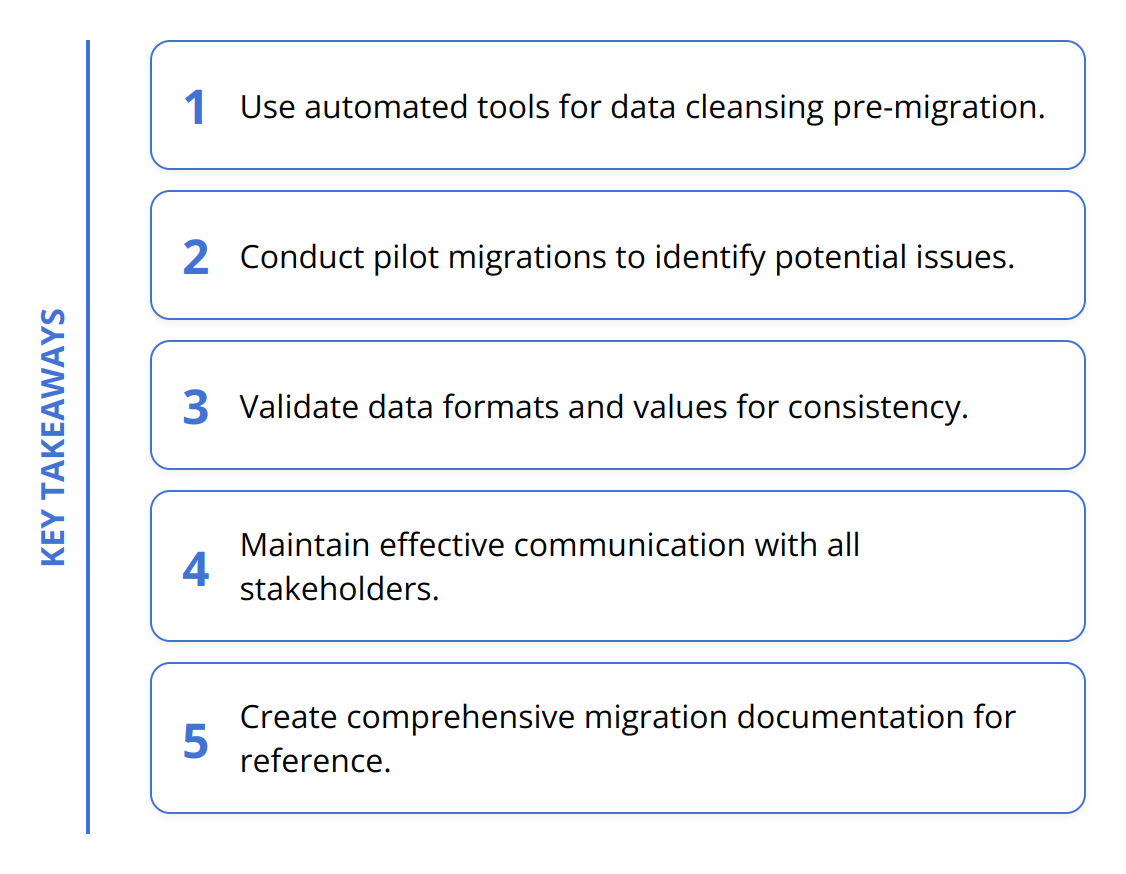Data migration is a critical step for organizations looking to optimize their operations and leverage new technology platforms. Here at Data Testing, we understand the complexities and challenges that come with moving data from one system to another.
Our guide focuses on best practices to executing this process smoothly, aiming to offer practical advice and insights for a successful migration journey.
Understanding Data Migration
The path to a successful data migration starts with a strong foundation of what data migration involves and why it’s vital for businesses. It’s the process of transferring data from one system to another, an operation that’s becoming increasingly necessary as companies evolve and adopt new technologies to improve their operations. However, this process is far from simple and comes with a set of inherent challenges.
Defining the Core of Data Migration
Data migration is not just about moving data; it’s about doing so efficiently while maintaining data integrity, minimizing downtime, and ensuring the data adapts to the new environment without loss of functionality or value. This process can significantly impact business operations, making it a key strategic move for organizations aiming to upgrade or consolidate their data storage solutions.

Breaking Down the Types
Several types of data migration exist, each with specific considerations:
- Storage migration, which involves moving data to a different storage device, often for performance, cost, or scalability reasons.
- Database migration, where data is transferred between two different database engines, necessitating data format transformations.
- Application migration, which requires moving application data to a new environment, often the most complex due to the differences in application architectures.
Understanding the type of migration you’re undertaking is crucial as it directly influences the approach, tools, and preparations necessary for a smooth transition.
Navigating Common Challenges
Data migration, despite its benefits, is fraught with potential pitfalls:
- Data loss or corruption is a real risk if the migration isn’t meticulously planned and executed.
- Downtime during migration can disrupt business operations, leading to losses.
- The cost can spiral if the project scope isn’t clearly defined or if unexpected issues arise during the migration.
- Compatibility issues between the old and new systems can cause data or functionality to be lost in translation.

To overcome these challenges, a strategic approach to data migration is mandatory. This involves careful planning, thorough testing, and choosing the right tools and technologies for the job. For example, employing a robust data migration tool can streamline the process, reduce risks, and ensure a smooth transition.
Here are some actionable tips to prepare for a successful data migration:
- Comprehensive planning and analysis before starting the migration to understand the scope and requirements.
- Regular backups to prevent data loss.
- Pilot testing to identify potential issues early in the process.
- Clear communication with all stakeholders to manage expectations and ensure alignment.
For those looking into specifics about database migration, including steps and tools, the article on database migration essentials provides valuable insights.
Data migration is an indispensable process for modern businesses. Done right, it can provide a competitive edge, streamline operations, and enhance data accessibility and security. However, the complexity and potential risks involved demand a well-thought-out strategy and a thorough understanding of both the process and the technologies employed. By acknowledging the different types of migrations and preparing for the common challenges, organizations can navigate their data migration journey with confidence.
Planning Data Migration
Effective data migration requires meticulous planning rooted in a clear understanding of goals and the current data landscape. Without a robust strategy, businesses risk data loss, increased costs, and extended downtimes—all of which can significantly impact operations. Let’s delve into how to lay a solid foundation for your data migration journey.
Set Concrete Goals
Begin by establishing what you aim to achieve with your data migration. Whether it’s improving system performance, enabling new functionalities, or consolidating data platforms for better analysis, your objectives should guide every decision in the process. Clear goals not only provide direction but also serve as benchmarks for measuring success post-migration.
Understand Your Data
An in-depth data audit and analysis is non-negotiable. This step gives you a full picture of the quality, structure, and interdependencies of your current data. Ignoring this phase increases the risk of migrating obsolete or irrelevant data, leading to inefficiencies and clutter in your new system. Use your findings to cleanse and organize data before migration, ensuring only valuable, accurate data makes the move.
Select the Right Tools
The choice of data migration tools dramatically affects the efficiency and effectiveness of the process. Factors like data volume, complexity, source and target environments, and specific requirements like real-time data replication influence this decision. Opt for tools that align with your migration strategy, offer robust data validation and transformation capabilities, and support seamless transition without data loss. Tools like Varonis Data Transport Engine and DatAdvantage, for instance, cater to a range of migration needs, from security to compliance management.
In summary, successful data migration hinges on thorough preparation that spans clear goal-setting, detailed data assessment, and the strategic selection of migration tools. Approach each step with diligence and leverage industry-leading solutions to streamline your migration efforts.

For a deeper dive into choosing data migration tools and strategies, explore database migration essentials for more insights.
Ensuring Successful Data Migration
To achieve a successful data migration, focusing on data quality and integrity, rigorously testing throughout the migration process, and maintaining effective communication and documentation are vital. These aspects are the backbone of a migration project that delivers on its promise of enhanced system performance and operational efficiency.
Guarantee Data Quality and Integrity
Data quality is the cornerstone of a successful migration. Without it, you’re merely transferring problems from one place to another. To ensure data integrity, start by thoroughly cleansing and profiling your data before the migration. This move helps identify and rectify errors, duplicates, and inconsistencies.
Practical Tips:
- Use automated tools for data cleansing to speed up the process.
- Validate data formats and values to maintain consistency.
A detailed analysis of your data helps in understanding its structure, which is crucial for a seamless transition. Furthermore, maintaining data integrity involves setting up validation rules that check the data as it moves, thereby preventing corruption. For insights into database validation strategies, consider exploring database validation essentials.
Rigid Testing Protocols
Testing is not a one-off activity in data migration; it’s a continuous process that accompanies every phase of the migration.
Actionables include:
- Conducting pilot migrations to gauge the impact on your systems and identify potential issues.
- Running parallel operations between the old and new systems to ensure they produce the same output under identical conditions.
By implementing comprehensive testing strategies, you can address issues promptly and avoid last-minute surprises. Additionally, leveraging tools that can automate some of these testing procedures can save time and reduce manual errors, ensuring a smoother migration process.

Communication and Documentation
Effective communication among all stakeholders involved in the migration is paramount. It ensures that everyone is on the same page about timelines, expectations, and potential issues. Regular updates and meetings can help in identifying and resolving problems early on.
Documentation plays an equally crucial role:
- It serves as a guideline for the migration process, detailing every step taken.
- It helps in tracking changes and decisions made, providing clarity and accountability.
- It’s invaluable for post-migration troubleshooting and as a reference for future migrations.
Creating comprehensive documentation and maintaining open channels of communication pave the way for a transparent and accountable migration process. These practices are not just about preventing errors but about building trust and ensuring a collective effort towards the common goal.
To sum up, prioritizing data quality, enforcing rigorous testing, and ensuring robust communication and documentation are non-negotiable for a successful data migration. By adhering to these principles, organizations can navigate the complexities of data migration, minimizing risks and setting the stage for a successful transition. Following these guidelines helps transform data migration from a daunting task into a strategic opportunity for growth and improvement.
Final Thoughts
The journey of data migration is both a necessity and an opportunity for organizations aiming to stay agile and competitive. By embedding best practices into every stage of the migration process, businesses can not only mitigate risks but also unlock potential benefits, ranging from enhanced operational efficiency to improved data quality. Here are some key takeaways and considerations for a post-migration strategy:

- Planning and preparation are fundamental, requiring a thorough understanding of both the current data landscape and the objectives of the migration.
- Choosing the right tools is indispensable for a smooth transition. Tools that offer comprehensive functionalities can significantly reduce the complexity and time involved in data migrations.
- Ensuring data quality and integrity is non-negotiable. This starts with data cleansing and extends into continuous monitoring post-migration.
- Rigorous testing throughout the migration process helps in identifying and rectifying issues before they become problematic.
- Effective communication and detailed documentation are vital for aligning team efforts and serving as a reference for troubleshooting and future migrations.
Post-migration, the focus should shift to continuous improvement. This involves regular assessments to ensure that the data environment remains optimal and evolves in line with business needs. Monitoring system performance, conducting regular data quality checks, and staying responsive to feedback from system users are part of this ongoing process.
Approaching data migration with confidence and care is key. Understanding its complexities and embracing a strategic approach will navigate your project away from common pitfalls towards successful implementation. Remember, the goal is not just to move data but to enhance its value as a business asset.
We encourage you to view data migration not as a daunting challenge but as a strategic step forward. With meticulous planning, the right tools, and a focus on quality, your data migration project can set the foundation for future growth and innovation.
Explore how Vexdata simplifies data testing and enhances data accuracy for your migration projects. Visit Vexdata for more information on how our AI-driven, no-code solution can support your data testing needs across various platforms.
Data migration is a journey with immense potential for transformation. Embark on this journey with the knowledge and tools necessary to succeed, and your organization will reap the benefits for years to come.

